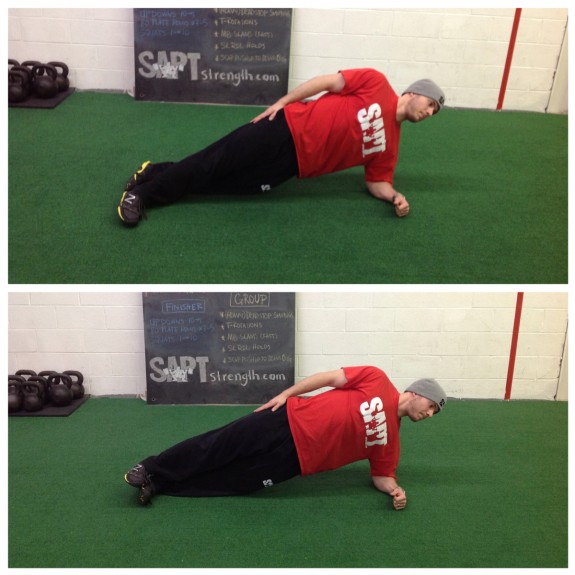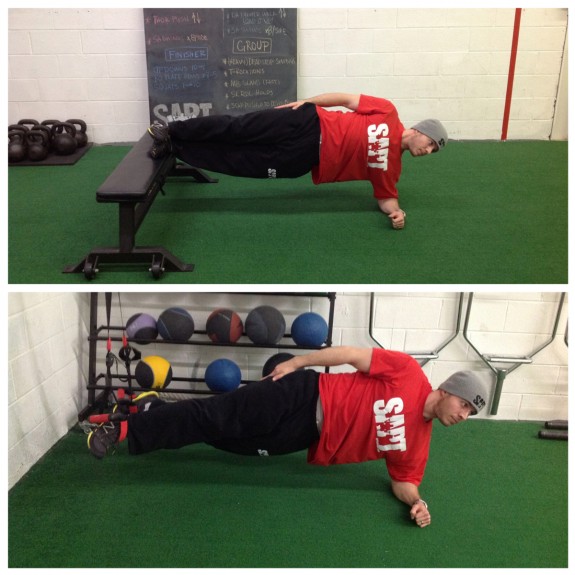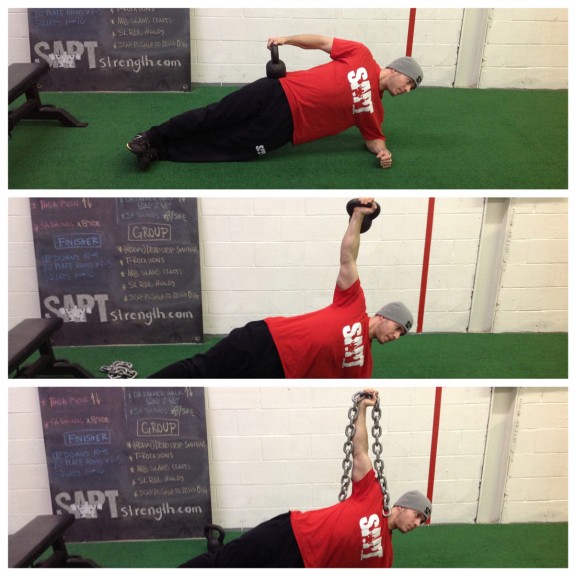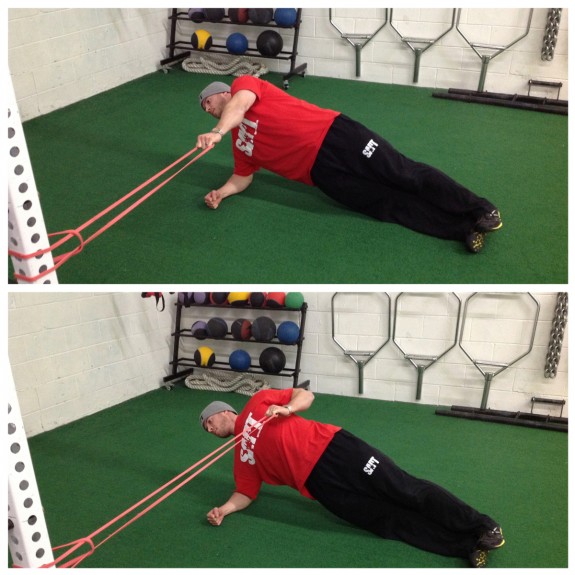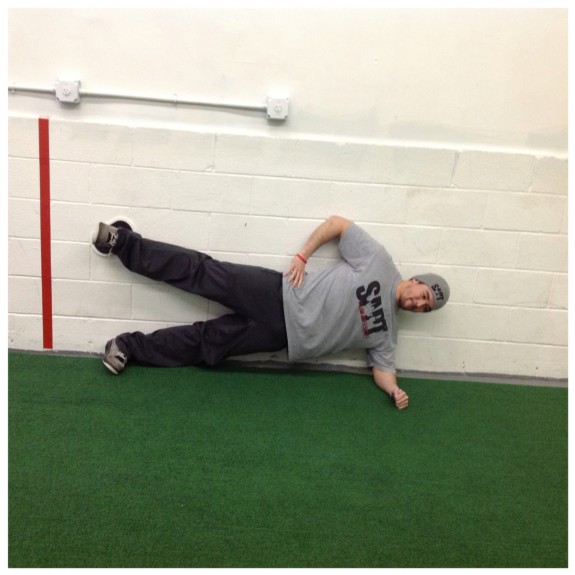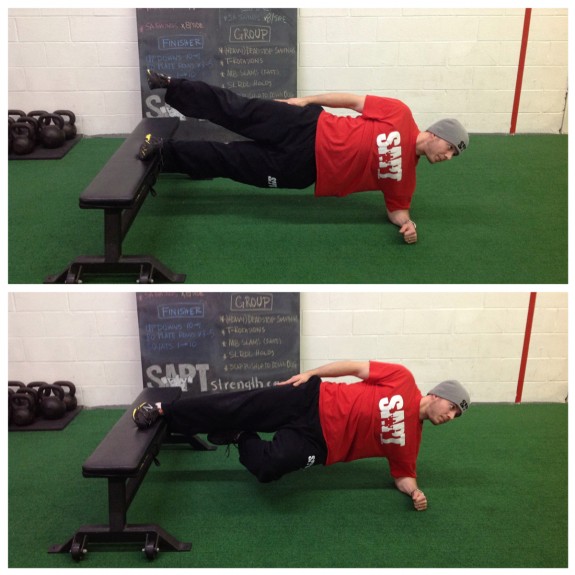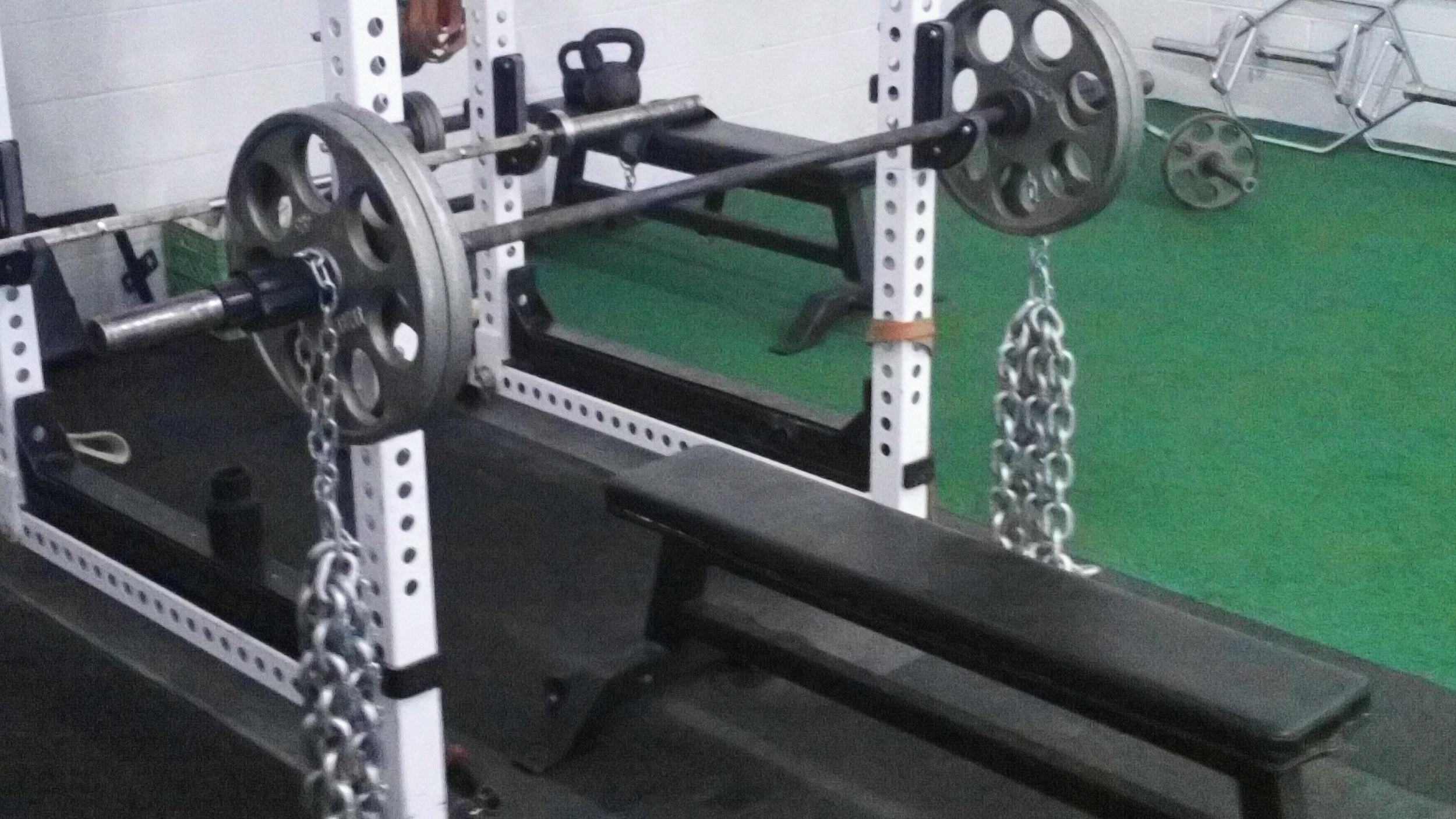Powerlifting Training for Sports
You must clearly understand the difference between basic training and special physical preparation. [SPP] is different for everybody; one beats up on a tire with a sledgehammer, another does figure eights with a kettlebell, and someone incline presses. Basic training is roughly the same in all sports and aims to increase general strength and muscle mass. Powerlifting was born as a competition in exercises everybody does.
— Nikolay Vitkevich
Don't you want to know more?
I wrote a guest post over at Concentric Brain you can read it HERE.
Lifting & Running = Monster Benefits - An Intern Post!!!
This week we're going with one theme: RunFAST. This is the new program we've been developing that we'll officially take the lid off of on Friday. I have to acknowledge, we're offering something totally new, so we're gonna take it slow and start with a post a bit more traditional in terms of the usual SAPTstrength banter. But check the blog every day this week. We've got 5 killer posts lined up.
For the first RunFAST post, one of our interns has written a fantastic post describing in detail the benefits of lifting for ALL TYPES OF RUNNERS (yes, you distance folks can enjoy this, too!).
Why should you listen to this guy who I just admitted is an intern, well, he's a special intern. His name is Gustavo Osorio (or Goose from here on out) and he just graduated from George Mason. Goose was a member of the track team and a stellar decathlete who very recently repeated as CAA champion! Pretty cool, right? This guy knows his stuff. I learned a few things myself and, given that I was his strength coach, that means he really knows some awesome details about high-performance.
I opened up comments again, so please post your thoughts and share with friends. Here we go:
Lifting And Its Benefits For Runners!
“Strength is the foundation for excellence,” this is a mindset I’ve come to respect and adopt for myself after my short time here at SAPT. When you think about it a strong body is a health body, one capable of efficiently moving in any way and letting a person’s athleticism truly shine. Strength is without a doubt the foundation for speed and agility. This concept that may seem foreign to many runners because of all the myths regarding resistance training and running. Many runners and even some running coaches are under the impression that hitting up the weight room once in a while will only result in injury, getting “bulky”, and losing that speed they’ve worked so hard to achieve. When, in reality, a well-structured resistance training program can make the body bulletproof, make your muscles more efficient without bulk, and boost the training effects of your running workouts (aka make you faster).
Myth #1: Lifting (squatting and deadlifting) is bad for your back. Don’t do it!
When performed correctly and with the appropriate assistance work squats and deadlifts can help you build a bulletproof back, glutes, and hamstrings. All three of these muscle groups also happen to be three of the most common sites for sprains and injuries on runners. Coincidence?? I think not! When running you’re lower back acts as a shock absorber, while the glutes and hamstrings are used for force production to propel the body forward. If an individual doesn’t strengthen these muscle groups and continues to constantly hammer them with more running eventually the muscles breakdown from overuse and an injury occurs.
On the other hand, if an individual strengthens these muscle groups they reduce their chances of injury and increase the work load their body can handle. This means they’ll be able to put in more work on the track during practice and, when meet day arrives, fast times will be run!
Fun fact about elite runners, whether it be a sprinter or a distance runner, is that they have some type of year around resistance training program implemented into their training. When you get to the Olympic level and everyone is tenths of seconds away from each other, keeping your body healthy through resistance training makes the difference between being an Olympic medalist and not making the final.
Myth #2: Lifting will make you bulky and slow
A big fear amongst runners is that resistance training will put on too much “useless” muscle for them to carry around. Truth is, a resistance training routine will make you bulky and slow ONLY if you completely stop running and if you have no idea of how to make it sport specific. Just because you’re lifting weights doesn’t mean you’ll turn into the hulk overnight (or ever... let's be real here) but it can make your muscles more efficient at what they do. By training your energy systems through lifting you’re running can be exponentially enhanced. Think of your body as a car and that the energy systems providethree different types of fuel it runs on. These BIG 3 are: the phosphagen system, the anaerobic system, and the aerobic system.
The phosphagen system provide the equivalent of jet fuel for the body. It gives you tons of energy but it burns out super fast! How fast you ask?? Well it gives you enough for 6 to 10 seconds of all out exertion. It provides the energy for the beginning of every race and it is the most dominant energy system during short running event, 60 meters to 100 meters. It is also involved in any sport that requires any sudden bursts of speed and explosion such as basketball, baseball, football, and volleyball. This system is primarily trained through plyometrics and lifts that require high force production at high speeds.
The anaerobic system gives you a mix between jet fuel and regular gas, it still yields a high amount of energy and manages to last a bit longer, between 1 to 3 minutes depending on the intensity of the event. This system is the most dominant for the 400-800 meter distances.It is also involved in sports that require prolonged bouts of speed and some endurance such as boxing, wrestling, lacrosse, and soccer. This is a tricky energy system to train because it requires a mix of power training, muscular strength training, and some muscular endurance training.
The aerobic system gives the body the same effect gas would in a car, it doesn’t let you go blistering fast but it give you a constant stream of energy to keep you going for miles. This is the dominant system in athletes who compete in endurance events such as triathlons, marathons, long distance swimming, and cross country skiing. This energy system can be trained through circuit training and low weight/high rep/low rest lifting.
**WORD OF CAUTION: Train a certain energy system through lifting does not mean you’ll necessarily get faster. When you integrate a lifting program on to a running program correctly the two can complement each other quite nicely. However if all you do is lift aerobically and then expect to go run a marathon you most likely won’t finish.**
Myth #3: Lifting has no positive transfer to running.
Another great benefit of resistance training is the improvement in something called your Rate of Force Development (RFD). [Side note: Kelsey did an amazing job of going into great detail on RFD, if you haven’t read her posts I strongly recommend them! Part 1 and Part 2.] Basically what that means is how fast your muscles can produce a high amount of force. This is beneficial to runners and all athletes because producing higher amounts of force at a faster rate enable you to move faster. Through training this can help optimize your stride length (amount of distance covered per step) and increase your stride frequency (how fast your feet hit the ground) both of which will also make you faster.
This last bit is something most people often neglect, but it makes a world of difference in their running. Aside from improving energy systems and Rate of Force Development lifting can be used to improve running posture. When performed correctly the squat and the deadlift teach people to brace their core and to properly align their back so it’s in the neutral position. A lot of people can go through an entire running career (like myself) without ever realizing that this has a massive positive transfer to running.
The two pictures above demonstrate how the body should be aligned during the deadlift and squat. If you take a side picture of yourself you should be able to draw a straight line from your hips to the base of the head.
Let’s take a look at Tyson Gay coming out of blocks. You can make a straight line from his hips to his head, JUST like a squat or deadlift! Coincidence?? I think not! By keeping his back in a neutral position and bracing his core he is getting the most propulsion out of the power he is putting on the ground. By keeping his core rigid (not tense) all the force being placed on the ground is not lost or being absorbed by an arched or hunched back. Same thing would happen if you lifted with a rounded back, the spine would absorb a lot of the force going up (deadlift) or down (squat) instead of letting your legs and glutes do the work.
Now take a look on the right at Carl Lewis, he is in the Maximum Velocity phase of the 100 meters which means he is trying to maintain his top speed for as long as possible. The line from the hips to the head is still there which means he is getting the most out of the force production. But that’s not all! Notice how his hip are neutral and not anteriorly rotated, his butt isn’t sticking out. This allows him to get a higher knee drive, cover more ground with his stride, and keeps him from kicking his leg too far back. A great way to teach this to people is the finishing position in the squat and the deadlift often referred to as the “lock out”. And like the squat/deadlift lock out phase if his hips were too posteriorly rotated, too far forward, he would put his back out of alignment and sacrifice kick back range of motion.
10 Reasons You Should Swing Heavy Bells
So, I forgot to post on Wednesday. Sorry folks! To make up for it, I present this: As the title states: Swing. Big. Bells.
Me and Natasha, just swinging around.
1. Glute strength- Do you want a strong butt? Of course you do, that's why you read this site. Swings are fantastic glute builders. The glutes are the most powerful hip extensors so it makes sense to perform exercises that force the glutes to extend the hips... hmmm, sounds like swings huh? The powerful snap of the swing carries over into other lifts such as the deadlift and squat. The glutes also play in vital role in sprinting and jumping. So if you want to be the Athlete-Of-Steel, you needs buns of steel. Swing it baby!
Gotta build the wheels if you want speed!
2. Upper back strength- During the swing, the upper back is essentially holding an isometric contraction to maintain the "chest up" postion throughout the swing. The lats are working hard to keep the bell close to the body (so it doesn't go flying away and pull you with it). The rhomboids and the teres major and minor are doing their duty of keeping the shoulder blades down and back and keeping the humerus in it's socket (kinda important). Guess what? Chin/Pull ups require those muscles too.
All my ButtKamp Ladies are swingers (the G-Rated kind, not the other kind) and ALL my ButtKamp Ladies' have improved in the pull up/chin up. We now have 2 women who are able to do a body weight chin up...(Suzanne, above, is one. The day after this, she nailed it!) pretty awesome! Personally, I've noticed an marked difference in my pull up strength, both my 1-rep max (weight on my waist) and my total rep max (how many I can do) have increased. With all the work the lats and upper back do in the swing, I don't think it's a cowinky-dink. Once again, the upper back strength also carries over to the big girl/boy lifts: squats and deads. Try performing either with a weak upper back and you'll find yourself stapled by the weight.
3. Injury prevention/rehab for lower backs- I professed my love and belief in swings for back rehab on Wednesday. The nature of swings, strengthening glutes, upper back, the spinal erectors, and core muscles, perfectly align with the needs of most back-pain sufferers. Most of us have, weak glutes, upper backs, cores, and spinal erectors. I know mine were (thus part of the reason I have injuries). While I can't claim that swings will heal any injury, they can at least prevent further injury (or injury if there isn't one present) and build up the muscles that protect the injury.
4. Grip strength- When your forced to grip a heavy weight while it's moving, you're going to build up some pretty strong hand and forearm muscles. One of my weak links in the deadlift (and pull ups) was my grip. I found this out pretty quickly once I started doing high rep, heavy swings. My forearms were on fire and my grip often gave out before the rest of me did. If you like picking up heavy things and walking around, swings will help build up an iron grip so you can pick up heavier things and walk around even more.
Keep on walkin'...
5. Cardiovascular and muscular endurance- Don't like running? Me neither. I do love to swing though. Swinging is excellent for building up cardiovascular endurance and muscular endurance (the ability for muscles to produce sub-max force over an extended period of time). Don't believe me? Try this: do a ladder of 1-2-3-4-5-6-7-8-9-10-9-8-7-6-5-4-3-2-1. Take a breath for every swing you do. How do you feel? Oh wait, I can't hear your over you pounding heart and labored breathing...
I see too many people talk while using this...
6. Core strength and function- During the swing, the midsection must remain tight not only to protect the spine, but also to transfer the force of the glute contractions into the bell to swing it. The core has to also be able to relax slightly so you can breathe throughout the workout (pretty important piece of exercise, that breathing. Generally, you inhale on the way down, brace on the way up, and breathe out forcefully at the apex of the swing.) and immediately brace for the next cycle of contraction as the bell swings forward. For those with back pain, sometimes the core muscles aren't firing in the right order. Swings help retrain the muscles in this sense.
7. Joint-Friendly conditioning- As mentioned, swings are pretty safe for those with back injuries (most of the time anyway). They're a perfect conditioning tool for those with cranky knees, ankles, and shoulders (mostly). They're also good introductory training for deconditioned individuals as they're scalable to individual strength and fitness levels. Unlike running, which essentially is thousands of one-legged hops, swings have very little negative joint impact (the elbows can take a beating if the upper back isn't doing it's job though so be prudent!) so it's less likely that you'll sustain an injury and want to quit exercising.
Done...
8. Leanness- This is more anecdotal than factual, but swinging promotes leanness better than any other form of conditioning I've run across (outside of regular sprint sessions, which can take their toll on the system physically as they're pretty stressful). Coach Dan John has spoken of the power of the swing to help athletes/trainees maintain a lower body fat percentage and I've noticed in myself as well. It's not going to be the magic bullet, but for those who train hard and eat pretty well, the addition of swings can help pull the body fat down a bit without too much stress to your system.
9. Overall strength- Swings involve the whole body, in case you couldn't tell from the above points. If you want to increase your strength, add some of these in and you'll be amazed at the carry over into the rest of your workouts/activities.
Hagrid-like strength in a little body
10. Self-Defense- If swings help build up the glutes and hamstrings, which are the primary movers and shakers of sprinting, should you be attacked by zombies or some other terrifying creature, you'll be able to scamper away pretty darn fast. Or, if you're brave, just swing your bell at them and let go. 60+ pounds to the face will mess any body up. Pretty sure Kathy could take down any foe.
If those didn't convince you then, well, I have no words.
For the Overextended Part II
A few months ago I wrote a post on warming up for those with a chronically overextended lumbar spine. Since then I’ve gotten a few requests for a sequel post, so... Without further adieu…
For the Overextended Part II: The Lift
In my first post I discussed “prepping” for the lift for those with exaggerated lordosis. I babbled about targeted stretching, mobilizing, and activation exercises used in conjunction with the idea that it would help “tuck” the hips under a bit more and reduce that ridiculous curve in the lower back that ails us.
For many that'll do the trick. After the warm-up they can feel their abs and glutes engage a bit more throughout their lifting session and they feel much more secure about their lower back health.
However, there are those that need more than a 15 minute warm-up to relieve them of their discomfort caused by the overextension. These might be the people with hip flexors that refuse to let go, erectors in constant spasm, and glutes that seem to have tragically passed away from years of desk work.
For these people with symptoms a bit more severe than the rest, some careful consideration should be taken into not only their warm-up but the structure of the lifting program itself. Here are a few exercises I like to use to fight against the overextension apocalypse.
Lower Body
Front Squats
For improved posture I tend to favor front squats over back squats mainly because it really helps to emphasize t-spine extension. Like I mentioned in my previous post, a hyperlordodic posture is often accompanied by significant kyphosis in the upper back. By focusing on keeping the upper back tight and the elbows up and in, front squats basically become a good way to practice good posture under resistance. (Practice makes permanent!)
Split Squats
Remember to do your split squats with all of the knee health rules in mind (keep the knee tracking straight ahead, try to keep a vertical shin), but add this one: squeeze the glute of your rear leg HARD the entire time. If you really flex that rear buttcheek you will feel a good stretch in that hip flexor as you descend to the bottom position.
Pull-Throughs and Glute Bridges
Keep hammering away at your posterior chain strength and emphasize the “tuck under” with your hips. Pull-throughs with a band or cable column is a great way to train the backside while avoiding any compression on your spine. Also throw in some glute bridges into your actual lift! They shouldn’t be reserved for just the warm-up.
Glute bridging variations are endless:
-Double Leg -Single Leg -Double Leg Concentric with Single Leg Eccentric -With a Barbell -With Chains -With a Barbell AND Chains -Back Elevated -Feet Elevated -Back AND Feet Elevated
Get to 'em!
KB Swings
Same idea as above: POSTERIOR CHAIN WORK. Perfect the hinge and develop incredible hip thrusting power. I recommend getting Kelsey or another well-qualified coach to supervise if you haven’t done them before. A correctly performed swing session can do wonders for your posture, but a bad swing sesh can wreak havoc on your lower back!
Upper Body
½ Kneeling Work
Do standing overhead presses and barbell rows make your lower back cranky? Fear not, and enter the ½ kneeling realm of pushing and pulling. Getting into the ½ kneeling position does a great job of positioning overextended spines back to neutral. Replace some of your pressing movements with single arm ½ kneeling landmine, kettlebell, or dumbbell presses. Then make sure to get your pulling in and grab a band or a cable column to do some ½ kneeling rows as well.
Push-Ups and Inverted Rows
Easy enough right? If you take away the movement from the upper extremities, these exercises become a plank or an isometric glute bridge, respectively. What I mean by that is you MUST make sure you keep your abs tight and your hips (NOT lower back) locked in extension as you do your push-ups and rows. When you feel like you’re starting to arch, call it a set or reset your hips.
Benching…?
Bench pressing can help improve my overextended posture?! No, I doubt it. However, I’m throwing it on here for a couple reasons 1) A lot of us are probably going to bench anyway. 2) It may be part of your team’s strength program for high school, college, or beyond.
Many trainees (including myself) prefer to bench with an arch. It helps to get into a position of better leverage and feels a bit smoother on the shoulders. When setting up to bench with a significant arch there is going to be some extension in the lower back, but you should try your best to emphasize the arch coming from the thoracic spine. If you cannot get into an arched back position on the bench without discomfort you still have options. You can simply bench with less of an arch, and by elevating your feet on weight plates you will be able to get a flatter back posture more comfortably. Another option you have is... don't bench. What?!
Floor Press
Take it to the floor! Bring your feet in and keep your back flat against the ground. That should quench your thirst for supine barbell pressing.
Anterior Core Work
Always throw in some work for your abs. Stronger abs will help pull that pelvis up in the front and decrease that anterior tilt. Anti-rotation presses, reverse crunches, roll-outs with a stability ball or an ab-wheel, and stir-the pots are all good options. One of my favorites is a plank. Boring you say? Load it up! Start stacking plates on your back and try to PR every time.
Fin That’s it for now. Can’t guarantee a part III, but you never know!
15 Variations of the Side Plank
The side plank is one of those exercises I find myself frequently tossing out of my quiver of training options, only to find myself continually coming back to it saying, "Why did I stop doing these again?" Or, "Tell me why I stopped giving these to my athletes?" It's a fantastic exercise that I feel should be imperative in every single beginner program - to teach them core stability, resisting lateral flexion, etc. - but can also be extremely useful as a warm-up or "filler" exercise for more advanced trainees.
Bottom Line: You are never either too novice or too advanced for the side plank, it's just a matter of finding the right fit for you personally.
Here are 15 variations of the good ol' fashioned side plank, be you a beginner or an advanced trainee.
Oh, and don't be a fool like I was during these photos with the extremely grody head positioning. Apparently I didn't want to look Tadashi in the eye as he snapped these; either that, or I felt like looking off into the horizon. The chin should be neutral, or "packed." Geeze, why did that guy in the red demo these, anyway?
Level 1: Short Lever and Torso-Elevated
I personally find the knees bent, or "short lever," variation MUCH better suited for those who are new to training and/or are dealing with low back pain. For whatever it's worth, I've found that, in some cases, elevating the torso even seems to make it harder then doing it on the flat ground.
If I'm working with someone on their first day, and I'm doubtful that they can do a normal side plank without collapsing in the first 5 seconds, I'll usually go with the short-lever first to set them up for success, and then progress accordingly if they feel good.
Level 2: Staggered-Feet and Standard
(Note: Staggering the feet is typically easier than stacking them)
Level 3a: Feet-Elevated Side Plank, Stable Surface or Suspension Straps
Level 3b: Weighted Side Plank w/Weight On Hips, or Weight Held Overhead)
You can certainly use a dumbbell (or even a weight plate) instead of a kettlebell on the hips, but I find the kettlebell feels much more natural when holding it overhead. The overhead chain hold adds a nice stability challenge, since it will want to sway on you.
Level 4: Side Plank + Band (or Cable) Row
This is one of those "fun" ones as it's less boring than remaining static, but it also provides all the benefits of horizontal pulling.
Level 5: Side Plank w/Wall Slide
This variation is downright miserable, which is why I had Tadashi demo it for me. To keep yourself honest, place a furniture slider under your heel. Start with the feet stacked, then slide your heel up the wall, trying your best not to make a pain face as your glutes light on fire.
Level 6: Weighted + Feet-Elevated
Level 7: Single-leg + Feet-Elevated with Top Leg Support, Single-Leg +Feet-Elevated with Bottom Leg Support
These are pretty advanced, and definitely shouldn't be just handed out to anyone and everyone. When the bottom leg is supporting it will fry the abductors of that leg (assuming you are actually keeping your hips up), and when the top leg is supporting, your adductors will be screaming for mercy.
I generally like prescribe two to three sets of :10-:40 (depending) per side. If you can't hold a variation for at least :10 then it's probably too advanced, and I personally feel that anything longer than :40 per side is overkill for most. With the band row and wall slide, I recommend sets of 8-12/side reps for the row, and 5-8/side for the wall slide.
10 Things I'd like to Share from 2012
As I opened my computer this morning, it didn't take long to realize I had a list of non sequiturs running around my brain. As 2012 is drawing to a close, why not allow them to run around on paper, forming a random thoughts post. Here are 10 things I either remembered, learned, or simply felt like sharing from the past year: 1. Taking the time to teach an athlete to "sit into the hip" during the foundational phases of jump training in the frontal and transverse planes will do wonders for their athletic development, as they progress onward to more "advanced" stages of change-of-direction training and force transfer outside of the sagittal plane.
Notice how in the video above, I use a "soft knee" during each landing and and push my hips back to decelerate. This displays the proper utilization of the glutes and other active restraints of the hip to create "tri-planar" stability: eccentrially controlling flexion, internal rotation, and adduction of the femur upon each ground contact.
However, the video below shows how you'll typically see people perform lateral hurdle (or cone) hops. Note how I rely much more heavily on the passive supports of my body - namely, ligaments, menisci, and other joint structures - to decelerate each landing.
Many athletes will land with a "double step," or even fall over, when learning how to decelerate correctly for the first time. Investing ample time in mastering this entry-level progression will pay huge dividends later on within the realm of injury risk reduction, change-of-direction speed, and rotational power on the field.
2. I love coffee, and, as a result, one of the best parts of my day (other than a good poop) is preparing and enjoying a quality brew early in the morning. Either that, or visiting my favorite local coffee shop, Caffe Amouri, where I settle down to do computer work alongside my faithful squire, Aragorn.
The best decision I made this past year to enhance the morning experience of home-brewing coffee was to purchase a Clever Dripper to prepare my morning elixir. Some of you may recognize it as the "pour over" or "hand pour" method.
With it, you receive all the benefits of a french press - full extraction of the flavors and sugars of the bean - but without the "mud" that typically resides at the bottom of a the mug. The Clever Dripper also WAY easier to clean than a french press.
I highly recommend it for you coffee-lovers in the crowd.
3. Here's an important classification I like to use for differentiating between main lifts in and accessory lifts in program design: Any main movement can also used as an accessory movement, but not all accessory movements can necessarily be a main movement.
It may sound simple and borderline obvious, but it bears repeating for those that are unsure of how to set up their programs.
4. The wrong and right way to hip hinge during a squat. Be careful of overemphasizing the familiar "hips back" cue too much when either squatting yourself or teaching someone else how to squat, especially if an anterior-loaded squat pattern like a goblet squat or barbell front squat is being performed.
If you push your butt back too much at the start, then your body has nowhere to go but forward on the way down in order to find its center of gravity with respect to the bar position. I think it goes without saying that this is unfavorable, with regards to both safety and that whole getting stronger thing.
See the video above for a brief demonstration of what I'm referring to. The first two reps show what happens when you overdo the hip hinge at the start, and the third and fourth rep show how to properly push your hips back as you descend to the bottom.
5. I read through the Harry Potter series this year (yes, admittedly it was fantastic), and jotted down some memorable lines as I went along. Here are a few of them:
- "Indifference and neglect often do much more damage than outright dislike." ~ Dumbledore
- "If you want to know what a man's like, take a good look at how he treats his inferiors, not his equals" ~Sirius Black
- "It does not do to dwell on dreams, and forget to live." ~ Dumbledore
6. Speaking of literature, I'm currently reading A Game of Thrones, and it is spectacular, to say the least. The author, George R.R. Martin, does a phenomenal job of reeling you into the story relatively quickly, and the world he creates is a different than most fantasy stories in that he veers away from the typical character archetypes (few are totally good or wholly evil, you don't have the classic hero who overcomes impossible odds and is immune to corruption, etc.) and he breaks many of the "rules" of stereotypical fantasy.
Hint: Don't read it if you're afraid of your favorite and/or likeable characters to die.
Not to mention, Martin is an absolute master of metaphors, description, and overall wordplay. Read it, and thank me later.
And, while I've heard good things about the HBO series, it still doesn't count. Sorry. However, that still doesn't mean this picture is not awesome:
7. One of the most rewarding parts of my job, by far, is helping people to train around injuries. It's extremely humbling to have the opportunity to help countless individuals - be they just coming out of surgery or simply dealing with a "tweaked" ankle or knee - continue to get stronger despite an injury they recently received.
Below is a video of Conrad, a 64-year-old who recently underwent not his first, but SECOND, total knee replacement surgery within the past year. Instead of wallowing in misery over the fact he couldn't do lower body training for a while, he barged through the doors of SAPT, with a battering ram, asking us to prepare him for a powerlifting meet. Keep in mind this was just weeks after his total knee replacement.
We put him on a bench-specialization program, and the end result was him hitting a bench PR in an official meet.
He serves as such a great example to those - way younger than 64 years of age, mind you - who make excuses as to why they seemingly can't take time to care for their bodies.
8. The Hobbit was an excellent film. I honestly don't see how Peter Jackson, or anyone for that matter, could have possibly done a better job with it. Yeah, people are upset he's splitting it up into three parts, but to me that just shows how Jackson pays attention to detail, and wants to ensure they leave no stone unturned during the film. It also means we still have two more excellent experiences in the theater to look forward to around Christmastime.
I didn't want to read any of the reviews before I saw it, so I looked at them a couple days after seeing the movie. Upon reading just a few of them, it confirmed my notion that the opinions of movie critics are worthless and overrated.
9. When you set up for the basic plank (and its variations), choosing to go from the "bottom up" vs. the "top down" actually has significant impact on how much iliopsoas is recruited. Considering that heavy recruitment of the iliopsoas is generally unfavorable in core stability exercises, try setting up from the bottom up rather than the top down.
10. An admittedly strange and ungrounded pet peeve of mine is when people use the words "jealous" and "envy" interchangeably in conversation. They don't mean the same thing!
To clear the air: Envy generally implies a sense of covetousness or a desire for something that someone else has. Jealousy, on the other hand, relates to a sense of resentment due to rivalry or the fear of being replaced.
I readily admit I don't have grounds from which to stand upon this sense of annoyance, as I am far from a grammar expert myself, and I make grammatical errors all.the.time. but for whatever reason I can't get this one out of my head.
Note: If you enjoyed this list format, feel free to check out this post or this post that I wrote in 2011.


